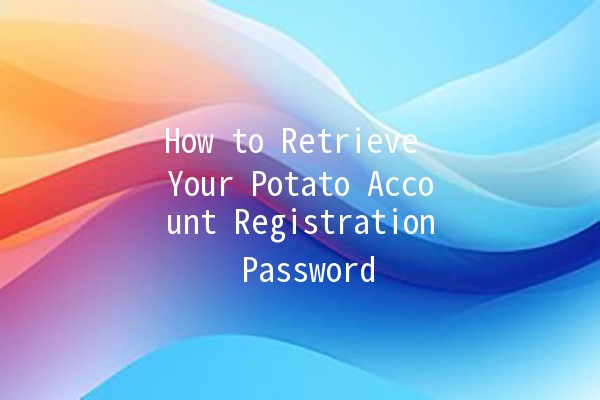Losing access to your online accounts can be frustrating, especially when it comes to retrieving a password for an account you rely on. If you’ve found yourself locked out of your Potato account due to a forgotten password, don’t worry! You’re not alone, and this article is here to provide you with practical tips and insights on how to regain access effectively while enhancing your productivity.
Understanding the Importance of Password Management
Before we delve into the specific methods for retrieving your password, it’s vital to understand why effective password management is crucial. Many people use the same passwords across multiple platforms, making them susceptible to hacking and data breaches. By learning how to manage your passwords wisely, you can significantly enhance your online security.
The Risks of Poor Password Management
Data Breaches: Utilizing the same password across multiple accounts increases the risk of a full account compromise if one is hacked.
Identity Theft: With insufficient password protection, sensitive information can be accessed, leading to potential identity theft.

Loss of Access: Forgetting passwords results in losing access to essential accounts, which can impact both personal and professional life.
Tips for Improving Productivity Through Password Management
Resolving password retrieval issues is just one part of effective account management. Below are five actionable tips to enhance your productivity when dealing with passwords.
Description: A password manager is a tool that securely stores and manages your passwords, generating strong passwords for your accounts.
Practical Application: Choose a reputable password manager like LastPass or 1Password. These tools encrypt your password vault, making it nearly impossible for anyone to access your passwords without your master password.
Description: TwoFactor Authentication adds an extra layer of security by requiring a second form of verification beyond your password, often through a mobile device.
Practical Application: Enable 2FA on your Potato account, which may involve receiving a text or email with a verification code whenever you log in from a new device. This adds peace of mind, knowing that even someone with your password cannot access your account without your other authentication factor.
Description: Many services, including Potato, offer recovery options such as security questions, secondary emails, or phone numbers.
Practical Application: Ensure your recovery methods are current by regularly checking and updating them. This way, if you do forget your password, you can easily retrieve it using the chosen recovery method.
Description: While it's essential to have strong passwords, it's equally vital to create ones that you can remember.
Practical Application: Use a phrase or a combination of words that are significant to you, along with a few numbers or symbols. For example, “MyDogFluffy$2023” is both memorable and strong.
Description: Updating your passwords regularly can help protect your accounts from unauthorized access.
Practical Application: Set a reminder every three to six months to update your passwords. This is particularly important for accounts that store sensitive data.
Steps to Retrieve Your Potato Account Password
Now that we’ve covered the productivity tips, let’s focus on how to retrieve your Potato account password using various methods available.
Method 1: Using the "Forgot Password" Feature
Method 2: Using Security Questions
If you opted to set security questions during your registration:
Method 3: Contacting Customer Support
If you cannot retrieve your password through the above methods:
Method 4: Check for Security Alerts
Sometimes, your Potato account can be compromised, prompting security alerts:
Frequently Asked Questions
If you don’t receive a password reset email:
Check your spam or junk folder to ensure it hasn't been marked incorrectly.
Ensure that you entered the correct email address associated with your Potato account.
If it's still not found, attempt the recovery process again or reach out to customer support for assistance.
While it might be tempting to use the same password for convenience, it's not recommended:
Using unique passwords for each account significantly reduces the risk of a security breach.
If one account is compromised, others with the same password will be at risk as well.
To ensure your new password is strong:
Use a minimum of 12 characters, including upper and lower case letters, numbers, and symbols.
Avoid using easily guessable information such as birthdays or names.
Consider using a passphrase made from random words or phrases that are meaningful to you.
If you suspect your account was hacked:
Immediately change your password using the steps outlined above.
Check your account for any unfamiliar activity.
Notify Potato’s customer support about any suspicious actions and follow their instructions.
It’s best to update your passwords every three to six months:
Regular updates help protect against unauthorized access, especially for accounts that store sensitive information.
Consider rotating passwords between accounts for better security.
It’s advisable to avoid accessing sensitive accounts over public WiFi:
Public networks can be insecure, with increased risks of data interception.
If necessary, use a VPN to enhance security while using public WiFi.
Bonus Tip: Educate Yourself
Continuously educate yourself about password security and best practices as new threats emerge. Awareness leads to safer online habits.
By following the aforementioned recovery steps and productivity tips, you can manage your Potato account more effectively, ensuring that you’re prepared for any passwordrelated challenges. Remember, good password management habits can significantly enhance your online security and productivity.